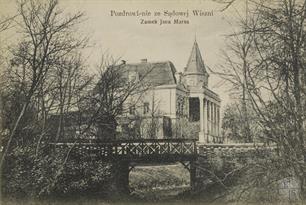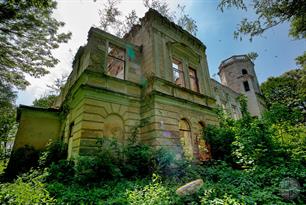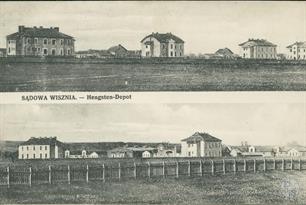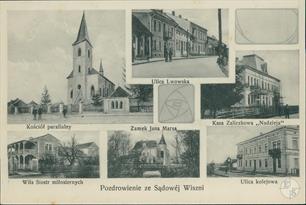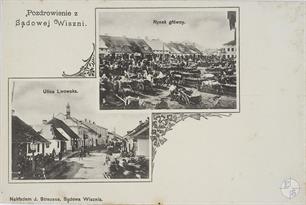Sudova Vyshnya
Yavoriv district, Lviv region
Sources:
- Virtual Shtetl. Sudova Vyshnia
- Słownik geograficzny Krуlestwa Polskiego i innych krajуw słowiańskich, vol. 10, eds. F. Sulimierski, W. Walewski, B. Chlebowski, Warsaw, p. 361.
- Encyclopedia of Jewish Life Before and During the Holocaust, vol. 2, eds. S. Spector, G. Wigoder, New York 2001, p. 1118.
Photo:
- Biblioteka Narodowa Polona. Sądowa Wisznia
- Wikipedia. Судова Вишня
- Wikipedia. Jan Mars Palace
- Virtual Shtetl. Sudova Vyshnia
- Słownik geograficzny Krуlestwa Polskiego i innych krajуw słowiańskich, vol. 10, eds. F. Sulimierski, W. Walewski, B. Chlebowski, Warsaw, p. 361.
- Encyclopedia of Jewish Life Before and During the Holocaust, vol. 2, eds. S. Spector, G. Wigoder, New York 2001, p. 1118.
Photo:
- Biblioteka Narodowa Polona. Sądowa Wisznia
- Wikipedia. Судова Вишня
- Wikipedia. Jan Mars Palace
Sudova Vyshnya (Ukrainian: Судова Вишня) is a town in Lviv region. First mentioned in the Galician–Volhynian Chronicle for 1230 as Vyshnia. In 1340, together with the entirety of Red Ruthenia, it was annexed by the Kingdom of Poland. Until the 1772 Partitions of Poland, Sądowa Wisznia, as it was officially called, was part of Przemyśl Land, Ruthenian Voivodeship.
Sudova Vyshnya received its Magdeburg rights town charter in 1368. Originally, it was called Vyshnia (Wisznia), after the river Wisznia, a tributary of the San. The adjective Sudova (Polish: Sądowa) was added in 1545, when it became the seat of the general sejmiks of the Ruthenian szlachta of Lesser Poland Province of the Polish Crown.
Sudova Vyshnya received its Magdeburg rights town charter in 1368. Originally, it was called Vyshnia (Wisznia), after the river Wisznia, a tributary of the San. The adjective Sudova (Polish: Sądowa) was added in 1545, when it became the seat of the general sejmiks of the Ruthenian szlachta of Lesser Poland Province of the Polish Crown.
First Jews appeared in Sądowa Wisznia in the mid-16th century. They were initially involved in running inns and taverns.
In 1880, the town had 1,100 Jewish inhabitants, constituting ca. 28% of the total population.
In 1890, their number increased to 1,309 – 30% of the population.
In 1921, however, the Jewish community shrank down to 1,039 people (24.7%), which was due to both warfare and intensified migration.
By the late 18th century, the Jewish community had become independent. At that time it was maintaining a synagogue and a cemetery.
The Zionist movement was active through the association “Zion” in 1902. In three years, a library and a reading hall were operating. However, the local population remained largely influenced by conservative circles.
In the interwar period, many Zionist organisations like “Beitar,” “Hokma,” and others were active.
During 1932-34, a Hebrew Tarbut school was operating.
The Jewish community of the town was destroyed by Germans during World War II. In 1942, three extermination operations were carried out in Sądowa Wisznia.
The first such “action” took place on 15 April 1942, when ca. 450 Jews were driven to the Janowska camp in Lviv. Most people deported in the second operation were also taken to the Janowska camp, while others were sent to the Belzec extermination camp.
At the beginning of December 1942, the last Jews remaining in the town were resettled (together with the inhabitants of Hussakуw [Husakiv], Janуw [Yaniv], Krakowiec [Krakovets], Krukienice [Krukenychi] and Mościski [Mostyska]) to the ghetto in Jaworуw (Yavoriv), which had been created on 10 November 1942. It was located in the southern part of the town and was fenced with barbed wire. After the deportation operation, the number of prisoners increased to ca. 6,000.
The prisoners of the ghetto were forced to endure abominable, unsanitary living conditions, which soon resulted in a typhus epidemic which claimed the lives of as many as 1,500 people.
On 16 April 1943, the ghetto in Jaworуw was liquidated – over 3,500 Jews were murdered on the spot, ca. 2,500 soon afterwards, while the others were killed over the following couple of days. Only ca. 200 prisoners were left alive. At the end of April 1943, they were resettled to the labour camp at Janowska Street in Lviv.
In 1880, the town had 1,100 Jewish inhabitants, constituting ca. 28% of the total population.
In 1890, their number increased to 1,309 – 30% of the population.
In 1921, however, the Jewish community shrank down to 1,039 people (24.7%), which was due to both warfare and intensified migration.
By the late 18th century, the Jewish community had become independent. At that time it was maintaining a synagogue and a cemetery.
The Zionist movement was active through the association “Zion” in 1902. In three years, a library and a reading hall were operating. However, the local population remained largely influenced by conservative circles.
In the interwar period, many Zionist organisations like “Beitar,” “Hokma,” and others were active.
During 1932-34, a Hebrew Tarbut school was operating.
The Jewish community of the town was destroyed by Germans during World War II. In 1942, three extermination operations were carried out in Sądowa Wisznia.
The first such “action” took place on 15 April 1942, when ca. 450 Jews were driven to the Janowska camp in Lviv. Most people deported in the second operation were also taken to the Janowska camp, while others were sent to the Belzec extermination camp.
At the beginning of December 1942, the last Jews remaining in the town were resettled (together with the inhabitants of Hussakуw [Husakiv], Janуw [Yaniv], Krakowiec [Krakovets], Krukienice [Krukenychi] and Mościski [Mostyska]) to the ghetto in Jaworуw (Yavoriv), which had been created on 10 November 1942. It was located in the southern part of the town and was fenced with barbed wire. After the deportation operation, the number of prisoners increased to ca. 6,000.
The prisoners of the ghetto were forced to endure abominable, unsanitary living conditions, which soon resulted in a typhus epidemic which claimed the lives of as many as 1,500 people.
On 16 April 1943, the ghetto in Jaworуw was liquidated – over 3,500 Jews were murdered on the spot, ca. 2,500 soon afterwards, while the others were killed over the following couple of days. Only ca. 200 prisoners were left alive. At the end of April 1943, they were resettled to the labour camp at Janowska Street in Lviv.

- Home
- Shtetls
- Vinnytsia region
- Volyn region
- Dnipro region
- Donetsk region
- Zhytomyr region
- Zakarpattia region
- Zaporizhzhia region
- Ivano-Frankivsk region
- Kyiv region
- Kropyvnytskyi region
- Luhansk region
- Lviv region
- Mykolayiv region
- Odessa region
- Poltava region
- Rivne region
- Sumy region
- Ternopil region
- Kharkiv region
- Kherson region
- Khmelnytskyi region
- Chernihiv region
- Chernivtsi region
- Cherkasy region
- Crimea
- Synagogues
- Cemeteries
- Objects & guides
- Old photos
- History
- Contact
Jewish towns of Ukraine
Jewish towns of Ukraine
My shtetl
My shtetl
Donate
